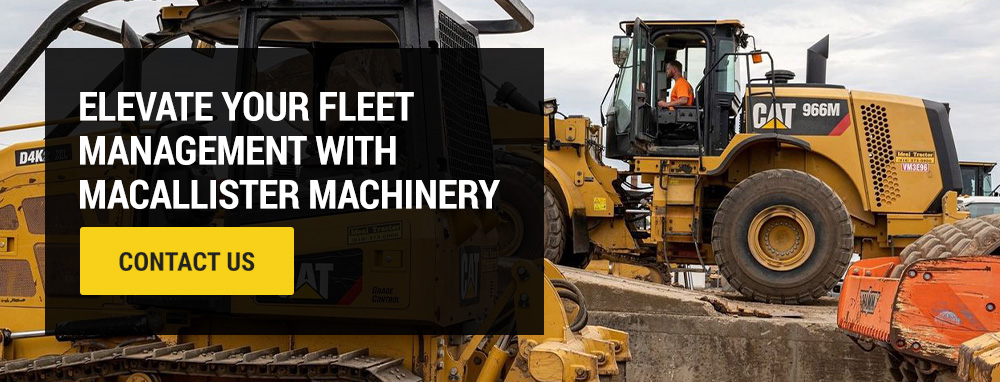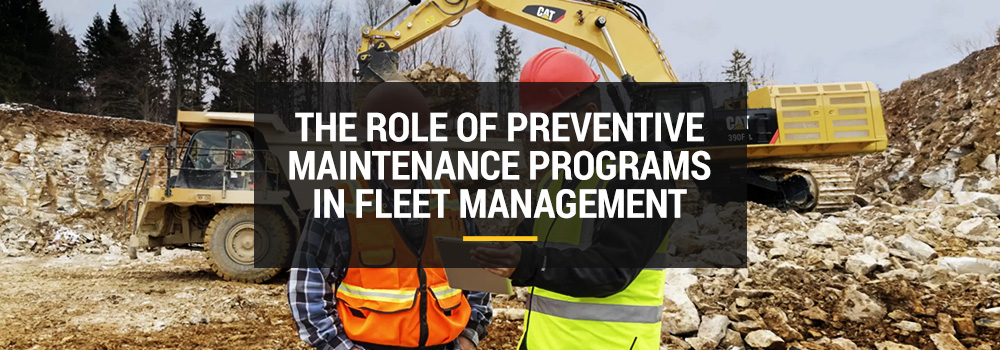 Preventive maintenance is the best way to reduce breakdowns within your fleet. By scheduling regular maintenance, you can improve overall uptime, avoid the costs associated with unplanned repairs and even extend the life span of your fleet’s assets. Read on to discover how to implement an effective fleet maintenance program and why it is a critical component of fleet management.
Preventive maintenance is the best way to reduce breakdowns within your fleet. By scheduling regular maintenance, you can improve overall uptime, avoid the costs associated with unplanned repairs and even extend the life span of your fleet’s assets. Read on to discover how to implement an effective fleet maintenance program and why it is a critical component of fleet management.
Jump to Sections:
- What Is Preventive Maintenance in Fleet Management?
- Key Steps to Setting Up a Fleet Maintenance Program
- Benefits of Preventive Maintenance Programs
- Strategies for Reliable Maintenance Cycles and Effective Inventory Control
- Comparing Preventive and Predictive Maintenance
- FAQs on Implementing Preventive Maintenance Programs for Fleets
- Elevate Your Fleet Management With MacAllister Machinery
What Is Preventive Maintenance in Fleet Management?
There are two types of maintenance within fleets — corrective and preventive. Corrective maintenance is unscheduled and performed as a reaction to a failed item on a piece of equipment. Preventive maintenance is a proactive approach to fleet maintenance, where regular upkeep is scheduled and performed to prevent the failure of equipment components. Preventive maintenance includes:
- Scheduled inspections: Preventive maintenance includes regular visual inspections and diagnostic tests to identify potential issues in your equipment. These tests could determine wear and tear and other problems before they become major issues.
- Routine servicing: Scheduled maintenance can also include changing fluids and filters, ensuring proper lubrication and adjusting components to keep your equipment running correctly and efficiently.
- Component replacements: During a preventive maintenance check, professionals can promptly replace parts that might be prone to wear and tear, such as hoses, filters, bearings and belts. They might also conduct a fluid analysis to detect contaminants and other issues early on. That way, you help prevent unexpected failures and associated costs.
- Documentation and record-keeping: Preventive maintenance also includes taking detailed records of your maintenance activities, equipment history, service schedules and inspection reports to track needs and ensure compliance with maintenance programs.
From construction and transportation to mining and agriculture, many industries use preventive maintenance to avoid breakdowns, extend equipment life span and ensure optimal performance. Whether you’re managing heavy equipment like excavators, bulldozers, drills, haul trucks or tractors, an effective maintenance plan can help you maintain this complex equipment and ensure it always works at peak condition.
Key Steps to Setting Up a Fleet Maintenance Program
Implement a preventive maintenance program for your fleet using the following steps:

1. Identify Your Fleet Maintenance Goals
Before diving into the details, outline your maintenance goals. Identify key performance indicators (KPIs) such as:
- Reducing downtime
- Cutting repair costs
- Extending equipment life span
Establishing clear objectives will help guide your maintenance plan. When you set your pre-defined thresholds, you can establish preventive maintenance plans for activities like equipment inspections, cleaning, testing, repairs, replacement of parts and other ongoing maintenance activities.
2. Create an Equipment Inventory
Develop a detailed inventory of your fleet, including information like:
- Make
- Model
- Year
- Mileage
- Maintenance history
Documenting this information helps you build the foundation for scheduling routine maintenance tasks and helps track the overall health of each piece of equipment.
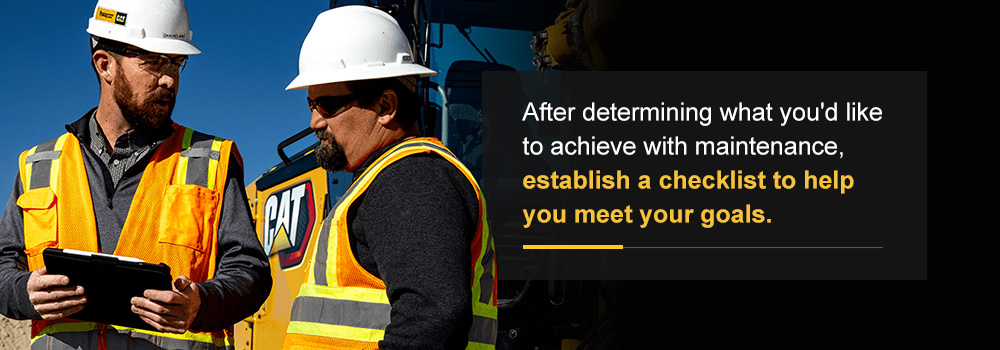
3. Establish a Maintenance Checklist
After determining what you’d like to achieve with maintenance, establish a checklist to help you meet your goals. An example of a maintenance checklist might be:
- General tune-up
- Body check
- Brake system check
- Assess electrical system components
- Replace brake pads
- Assess the quality of tires, wheels and rims
- Inspect the exhaust system
- Check for fluid leaks
- Change engine oil and filters
Your checklist will largely depend on the type of equipment that needs maintenance. Some equipment could require a quick check-up, while others may need a more robust inspection for compliance.
4. Determine Maintenance Intervals
You’ll also want to determine the right frequency for your maintenance and inspections, such as daily, monthly, weekly or annually. As mentioned, these intervals might depend on the type of equipment being maintained and how old it is. It’s best to refer to the guidelines set by the original equipment manufacturer.
5. Leverage Technology
Many businesses leverage technology to automate maintenance tracking and scheduling. Advanced fleet management software can streamline tasks and generate reports automatically without manual work on your end. These capabilities can save you time and energy while reducing the risk of errors. Look for useful features like:
- Fuel management
- Fleet alert system
- Location detection
- Route planning and monitoring
Quickly register any issues and submit reports, such as critical inspections, after operating equipment. Advanced tools can automate scheduling and provide real-time insights into your equipment’s condition.
For example, VisionLink is a web-based app you can use to quickly retrieve vital information about your entire fleet, including mixed fleets, revealing productivity levels and the health of all equipment. When used with Cat® equipment, you can view idle hours and fuel consumption and analysis to optimize maintenance efforts.
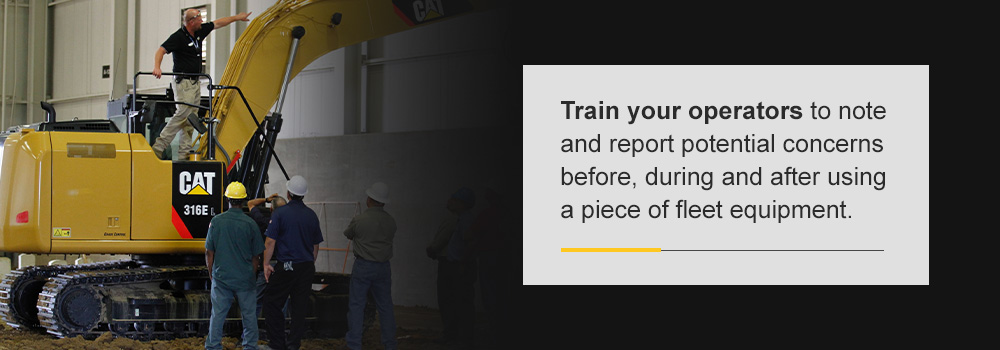
6. Develop Driver Inspection and Reporting Systems
Your equipment operators are your first line of defense in fleet maintenance management. The people who use the equipment most often can assess subtle signs and issues that might not be evident to even experienced technicians during routine inspections. Have operators monitor the following to report issues that require maintenance:
- Safety systems and parts like tires, braking systems and steering
- Operating behavior like misfiring or screeching brakes
- Interior and body of the equipment, including condition of seats or damage to mirrors or body
- Miscellaneous items like heating and air conditioning malfunctions
Train your operators to note and report potential concerns before, during and after using a piece of fleet equipment.
7. Track Metrics for Success
Use telematic systems to monitor your equipment’s performance in real-time. These systems monitor fuel efficiency, engine health and driving behavior, helping you identify potential issues early and optimize maintenance schedules.
Keep detailed records of your maintenance activities. You can analyze this data regularly to determine trends and areas for refinement. Data-driven insights help you refine and optimize your truck fleet maintenance program continuously. Encourage feedback from your maintenance team, monitor industry trends and adopt best practices to stay ahead of challenges.
8. Partner With Professionals
When implementing a maintenance plan, consider partnering with professionals. MacAllister Machinery can help you resolve glitches quickly and independently with in-depth preventative maintenance services and basic troubleshooting technical service training. Our expert team will help you find the products necessary for maintaining and repairing your equipment.
We use cutting-edge tools and technology to deliver fast, effective solutions. From fast and reliable technical support to 24/7 emergency repairs, we can help you reduce downtime and maximize productivity.
Benefits of Preventive Maintenance Programs
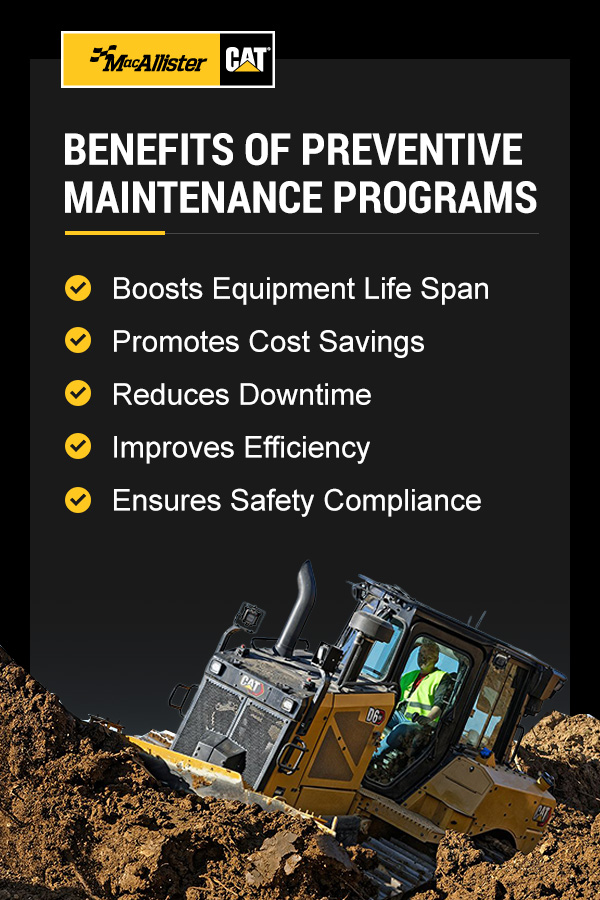 Implementing an effective preventive maintenance program offers the following benefits for your company:
Implementing an effective preventive maintenance program offers the following benefits for your company:
Boosts Equipment Life Span
Taking care of your equipment ensures it lasts longer, meaning you won’t need to replace it as soon. Several maintenance protocols can help reduce wear and tear and address issues promptly before they can turn into costlier breakdowns. For example, regularly scheduled lubrication and cleanings can reduce friction-related wear and remove dirt, debris and contaminants from equipment filters and components.
During regular inspections, you can also identify signs of wear, misalignment or damage to prevent further deterioration of equipment components. You might also proactively replace worn or damaged parts during regular maintenance, preventing further wear and potential failures.
Promotes Cost Savings
Major repairs can be expensive. Preventive maintenance helps you find and solve smaller issues before they become serious. Here’s how preventive maintenance can promote cost savings for your business:
- Reduced downtime costs: Preventing an emergency is infinitely less expensive than responding to one, as emergencies can lead to unplanned downtime. Preventive maintenance can translate into significant cost savings by avoiding lost production time, delayed project timelines and potential penalties for not meeting deadlines.
- Extended equipment life span: Implementing regular maintenance can keep your equipment components in optimal condition, leading to a longer life span and cost savings by delaying the need for early replacements.
- Improved efficiency and performance: Properly working equipment operates more efficiently, consumes less fuel and delivers better performance, translating to cost savings through lower fuel costs and increased efficiency.
- Lower repair costs: Emergency breakdowns often require additional labor costs due to overtime. Proactively addressing issues with preventive maintenance can prevent major problems later on, reducing the need for expensive repairs or replacements.
By avoiding major breakdowns, reducing repair costs and enhancing your efficiency, preventive maintenance programs can contribute to greater cost savings for your business and more long-term financial benefits.
Reduces Downtime
Reports show that 90% of engine failures are preventable, making it critical to invest in preventive maintenance for your fleet.
Equipment that is properly maintained is less likely to fail, which means you can keep production running. A lack of maintenance can also cause problems with quality, increasing waste and the need for rework. You’ll save time on rework and emergency shutdowns by implementing a regular maintenance program.
Additionally, effective preventive maintenance can help you manage your spare parts inventory more efficiently by identifying critical parts, reducing excess stock and ensuring timely availability of necessary components. You’ll no longer need to wait weeks or even months for parts to arrive when you’ve properly cared for your equipment.
Improves Efficiency
Equipment that isn’t maintained well often uses more energy. Preventive maintenance can keep efficiency up and utility bills down. It helps ensure reliable and smooth operational performance. Your equipment will consume less fuel, which can contribute to cost savings and increased productivity.
Regular maintenance tasks like lubrication and adjustments can ensure equipment runs well and operates efficiently. That way, your fleet will deliver better performance compared to equipment that is neglected or only repaired reactively.
Ensures Safety Compliance
By implementing maintenance programs, you can promote safer working conditions by reducing the risks of malfunctioning equipment. You also ensure your equipment is safe to operate and meets regulatory compliance standards.
Maintaining your equipment in optimal condition can help you avoid costly fines, penalties or legal liabilities resulting from safety violations or non-compliance.
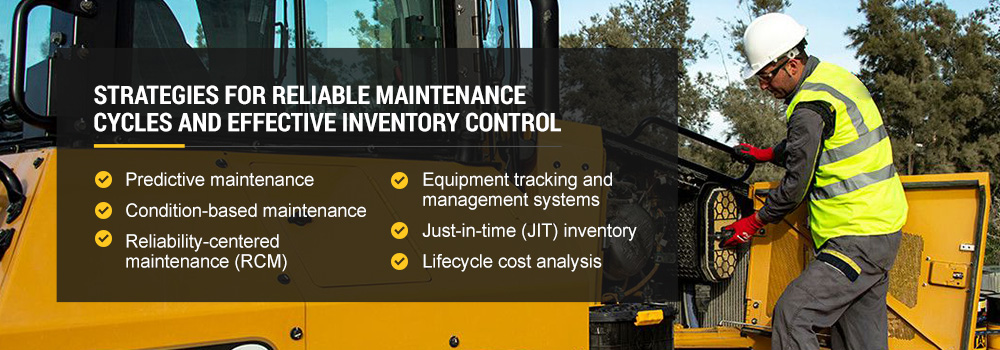
Strategies for Reliable Maintenance Cycles and Effective Inventory Control
Maintain reliable maintenance cycles and effective inventory control with the following strategies:
- Predictive maintenance: Make use of data analytics, sensor technology and equipment monitoring to predict equipment failures before they occur. Predictive maintenance strategies can help you schedule maintenance at the correct times and avoid downtime.
- Condition-based maintenance: Condition monitoring techniques can help you target maintenance efforts where they are most needed. Vibration analysis, thermography and oil analysis can all assess the condition of your equipment so you know when to schedule maintenance.
- Reliability-centered maintenance (RCM): Use RCM principles to prioritize your maintenance based on impact on operations, cost and safety. RCM helps you focus your maintenance tasks on the most critical assets, ensuring reliability and maximizing uptime.
- Equipment tracking and management systems: Advanced tracking and management systems can provide you with real-time data on equipment usage, performance, maintenance history and upcoming service needs. These systems can help you plan for maintenance, schedule tasks and ensure effective inventory control of your spare parts.
- Just-in-time (JIT) inventory: Use JIT principles for maintenance and supplies management, where you replenish inventory only as needed. This can reduce excessive inventory holding costs and ensure you get the parts you need for maintenance as needed. JIT inventory control can help you optimize inventory levels, reduce carrying costs and improve cash flow.
- Lifecycle cost analysis: Analyze your lifecycle costs to assess the total costs of owning equipment, including the maintenance, repairs and replacements over its life span. Understanding these costs can help you make informed decisions on maintenance cycles, inventory investments and equipment replacement to optimize costs and performance in the long run.
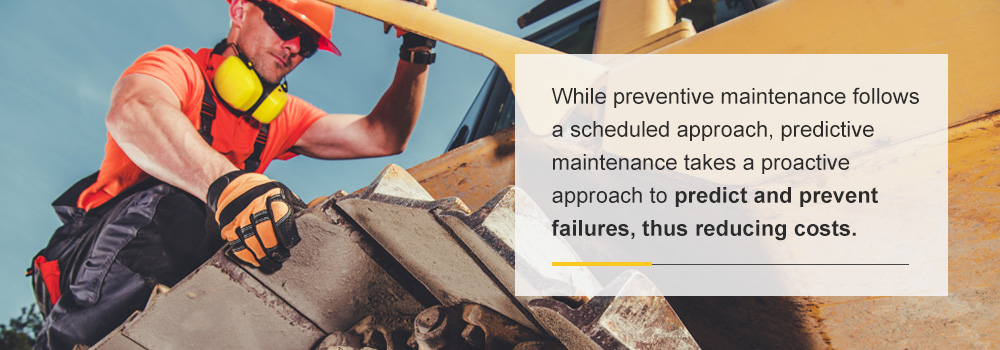
Comparing Preventive and Predictive Maintenance
Keeping your facility’s equipment in proper working order is critical, and ideally, you will want to address minor issues before they lead to costly shutdowns. Using both preventive and predictive maintenance can help you stay on top of everyday wear and tear. While they sound similar, they involve different approaches:
- Proactive vs. scheduled approach: While preventive maintenance follows a scheduled approach, predictive maintenance takes a proactive approach to predict and prevent failures, thus reducing costs.
- Technology differences: Predictive maintenance leverages technology to predict issues, while preventive maintenance uses notifying software to signal to caretakers about upcoming maintenance services.
- Downtime differences: Preventive maintenance requires downtime for maintenance tasks, while predictive maintenance does not require downtime since maintenance is done proactively.
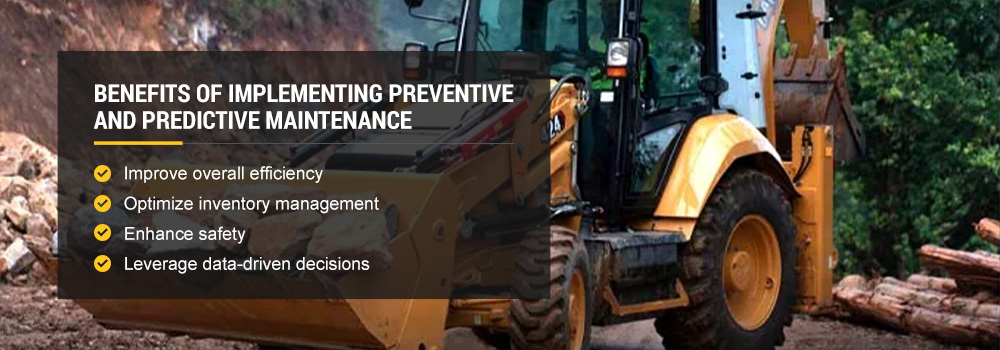
Benefits of Implementing Preventive and Predictive Maintenance
Both predictive and preventive maintenance benefit facilities, making it important to employ strategies from both.
- Improve overall efficiency: Improve efficiency and minimize disruptions by addressing potential problems before they escalate.
- Optimize inventory management: You can also improve safety measures and optimize inventory management through better planning and forecasting, decreasing inventory carrying costs.
- Enhance safety: You can promote a safer environment for operators and mitigate risks associated with unexpected equipment malfunctions by using both predictive and preventive maintenance.
- Leverage data-driven decisions: Using predictive and preventive maintenance strategies helps facilitate better decision-making by using real-time equipment health information and performance data history.
When you establish a proactive approach to maintenance, you foster a culture of continuous improvement and equipment reliability within the organization.
FAQs on Implementing Preventive Maintenance Programs for Fleets
Here are answers to some of the most common questions fleet managers have about preventive maintenance programs:
1. What Are the Key Components of a Fleet Preventive Maintenance Program?
The key components of a preventive maintenance program are:
- Scheduled inspections
- Fluid checks
- Filter replacements
- Tire rotations
- Brake inspections
Depending on your specific piece of equipment and needs, you might employ the above services as well as other routine maintenance tasks. Using technology to track maintenance schedules and equipment history is also a critical part of preventive maintenance programs.
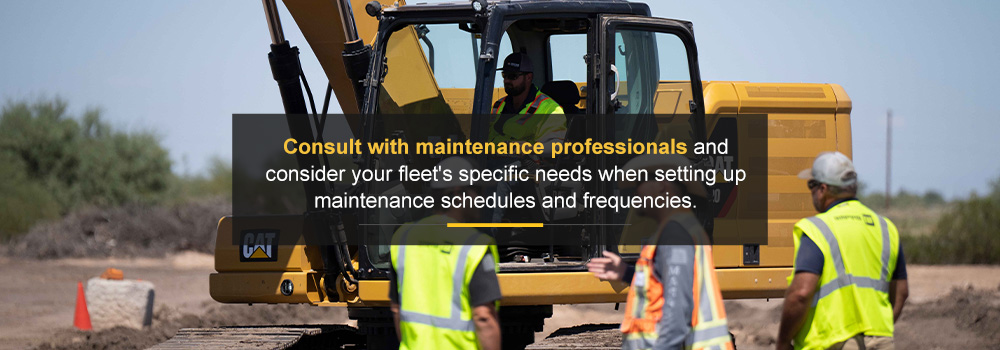
2. How Do You Determine the Right Maintenance Schedule for Your Fleet?
The maintenance schedule for your fleet should be based on factors like:
- Equipment usage
- Manufacturer recommendations
- Industry standards
- Past maintenance history
Consult with maintenance professionals and consider your fleet’s specific needs when setting up maintenance schedules and frequencies.
3. Why Is Preventive Maintenance Important?
Preventive maintenance is important for ensuring fleet reliability, reducing downtime and minimizing repair costs. Investing in maintenance and being proactive about services can help you save in the long run, enhancing the success of your operations.
4. How Can You Measure the Effectiveness of Your Preventive Maintenance Program?
You can access the effectiveness of your program by tracking metrics like:
- Fleet downtime
- Repair costs
- Fuel efficiency
- Equipment reliability
Analyzing these metrics over time can help you improve and optimize your maintenance program.
5. What Role Does Technology Play in Fleet Preventive Maintenance?
Technology can offer the following for your maintenance program:
- Real-time monitoring of equipment health
- Automated maintenance alerts
- Digital maintenance records
- Predictive maintenance capabilities
Telematics, fleet management software and Internet of Things devices can support your maintenance programs and enhance their efficiency.
6. How Can You Ensure Compliance With Preventive Maintenance Regulations and Standards?
Meet compliance by staying updated on industry regulations related to fleet maintenance and ensuring the program aligns with these requirements. Partnering with trained technicians and maintenance staff, documenting activities, and doing audits can help you maintain compliance.
Note that preventive maintenance programs are critical for operator safety. If equipment becomes unsafe due to a lack of maintenance or repair, you may face civil liability and fines.
7. What Are the Benefits of Outsourcing Preventive Maintenance?
Outsourcing your maintenance tasks to specialized service providers can offer numerous benefits, including:
- Access to expert technicians
- Reduced administrative burden
- Cost savings from expert services
- Improved service quality
No matter the size of your business, working with a partner company to complete these tasks for you can be exactly what you need to expand and succeed. Still, evaluate the pros and cons of outsourcing based on your fleet size and specific needs.
Elevate Your Fleet Management With MacAllister Machinery
Preventive maintenance is a critical aspect of fleet management. Prioritizing preventive maintenance can help reduce emergencies and downtime while enhancing your equipment’s efficiency. Partnering with a reliable dealer ensures prompt, convenient and effective preventive maintenance. It can also help you minimize job disruptions and maximize your investments in your equipment.
At MacAllister Machinery, our technicians are highly skilled at troubleshooting any issues you may have. The team can also make recommendations for regular services based on how often you use your equipment and what your work environment requires. We can service your equipment and get you back in operation as quickly as possible.
For fast and reliable Cat engine maintenance, choose MacAllister Machinery service solutions today. Contact us for more information on preventive fleet maintenance.

